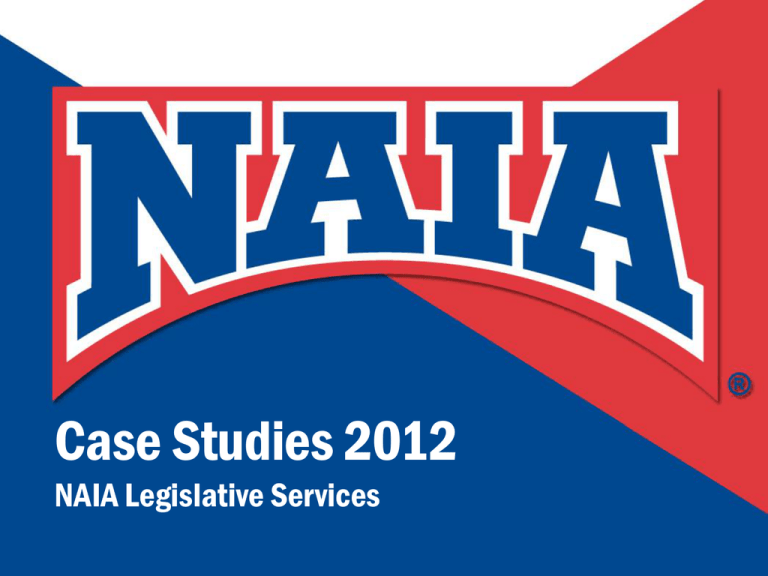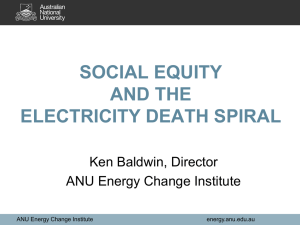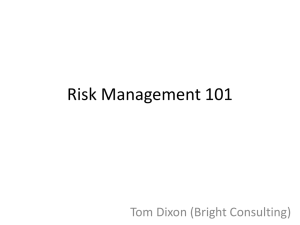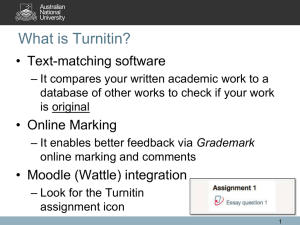Rationale: Article V, Section C, Item 2
advertisement

N A T I O N A L A S S O C I A T I O N O F I N T E R CO L L E G I A T E A T H L E T I C S Case Studies 2012 NAIA Legislative Services ‹#› N A T I O N A L A S S O C I A T I O N O F I N T E R CO L L E G I A T E A T H L E T I C S Glossary: TOA = term(s) of attendance SOC= season(s) of competition 24/36 Hour Rule = eligibility requirements in V.C.6 Progress Rule = eligibility requirements in V.C.9 EC = Eligibility Center ANU = Awesome NAIA University ONC = Other NAIA College JuCo = two-year institution ‹#› N A T I O N A L A S S O C I A T I O N O F I N T E R CO L L E G I A T E A T H L E T I C S Recruiting Matt H. participated in men’s swimming at the University of Kansas for two years. Matt calls ANU’s head swimming coach and tells the coach he is thinking about transferring to ANU. You, as FAR, recently read a press release issued by the University of Kansas that it will no longer sponsor varsity men’s swimming. Does ANU need to notify the University of Kansas in writing within 10 days of Matt’s contact with the coach? 1. Yes 2. No ‹#› N A T I O N A L A S S O C I A T I O N O F I N T E R CO L L E G I A T E A T H L E T I C S Answer: Yes Rationale: Article II, Section D, Item 1 The announcement of a program’s discontinuance does not create an exception to NAIA recruiting rules. The recruiting bylaw applies to any “enrolled” student. Your institution is required to give notice to the University of Kansas Athletic Department within 10 days of contact even if there is no longer a men’s swim team. ‹#› N A T I O N A L A S S O C I A T I O N O F I N T E R CO L L E G I A T E A T H L E T I C S Mid-year Eligibility Jimmy Chitwood is a first-term freshman basketball player identified at ANU. Jimmy initially received an “Ineligible” determination from the EC (no class rank and 16 on the ACT). Jimmy takes the ACT again in October and scores a 24. (His dog was sick on the first attempt). On Nov. 12th ACT sends the scores to the EC and he receives an “Eligible” determination for the fall term. Provided he is otherwise eligible, when may Jimmy begin participating? (ANU does not offer an inter-term.) 1. Upon EC determination and placement on the eligibility certificate. 2. The first day of classes of the winter/spring term. 3. The day after the last day of the fall term. 4. Jimmy did not meet V.C.2 and must sit the entire year. ‹#› N A T I O N A L A S S O C I A T I O N O F I N T E R CO L L E G I A T E A T H L E T I C S Answer: #3 – Day after last day of fall term Rationale: NEC Interpretation of Article V, Section D, Item 2 A student is eligible for athletics participation on the day following the close of a term, provided the student meets all eligibility requirements for the upcoming term and is properly certified as eligible. The close of the term is the date on the institution’s calendar marking the official end of the term. ‹#› N A T I O N A L A S S O C I A T I O N O F I N T E R CO L L E G I A T E A T H L E T I C S Mid-year Eligibility Jimmy Chitwood is properly placed on the eligibility certificate and begins participating with your men’s basketball team the day following the close of the fall term. In February, ACT sends notice to ANU and the NAIA EC that Jimmy’s test score is no longer valid. ANU immediately withholds Jimmy from further participation. Which statement is most accurate based on known facts? 1. Jimmy is immediately ineligible for failing to meet V.C.2. 2. ANU must forfeit any games in which Jimmy participated. 3. ANU must submit a self-report violation. 4. None of the above. ‹#› N A T I O N A L A S S O C I A T I O N O F I N T E R CO L L E G I A T E A T H L E T I C S Answer: #1 – Immediately Ineligible Rationale: Article V, Section C, Item 2 An invalidated test score immediately nullifies information submitted to the NAIA Eligibility Center. As such, Jimmy no longer meets the freshman 2 of 3 requirement and is ineligible for further participation. The case could go before NEC or CEC for forfeits and/or penalties if SAT or ACT provides additional information pertaining to student-athlete misconduct. ‹#› N A T I O N A L A S S O C I A T I O N O F I N T E R CO L L E G I A T E A T H L E T I C S Amateurism Willie Mays Hayes competes in baseball and track at ANU. Willie attends a greyhound race with friends during the summer. The race track offers $500 to anyone who can beat a greyhound in a race (with a head start). Willie’s friends convince him to accept the challenge and he eventually beats the dog. Willie claims his $500. Which statement about Willie’s amateur status is correct? 1. Willie will lose his amateur status in baseball. 2. Willie will lose his amateur status in track and field. 3. Willie will lose his amateur status in all NAIA-sponsored sports. 4. Willie will not lose his amateur status in any sport. ‹#› N A T I O N A L A S S O C I A T I O N O F I N T E R CO L L E G I A T E A T H L E T I C S Answer: #2 – Loss of Amateur Status in T&F Rationale: Article VII, Section D, Item 4 In general, NAIA amateurism rules are sport specific. VII.D.4 is a bit of an adaptation in that it addresses receiving remuneration from athletic ability related to an exhibition involving the primary focus of a particular sport. In this case, Willie exploited his running ability for $500 at the exhibition. ‹#› N A T I O N A L A S S O C I A T I O N O F I N T E R CO L L E G I A T E A T H L E T I C S Graduation Ester W. completes all requirements for her baccalaureate degree at the end of her 8th TOA at ANU. She has 1 season of competition remaining in swimming. Provided she is otherwise eligible, what is the correct academic path that allows Ester to participate in her last SOC in swimming? 1. Withhold filing for graduation to prevent meeting “requirements for graduation.” 2. Enroll in 12 credits toward an additional minor program at ANU. 3. Enroll in a post-baccalaureate teacher program at another school. 4. Enroll in 12 credits toward a second major at ANU. ‹#› N A T I O N A L A S S O C I A T I O N O F I N T E R CO L L E G I A T E A T H L E T I C S Answer: #4 – Enroll in 12 hrs toward a 2nd major Rationale: Exception to Article V, Section D, Item 5 A student completing all academic requirements for graduation retains eligibility only if the student is enrolled in any of the following at the institution where the student earned his or her baccalaureate degree: Graduate or professional school, 5th year teacher education program, or A second major area of study ‹#› N A T I O N A L A S S O C I A T I O N O F I N T E R CO L L E G I A T E A T H L E T I C S Repeat Courses Tom C. achieves a “D” in ECO 101 (Principles of Economics) at ONC. He transfers to ANU where the school does not transfer credits earned with a “D”. Tom enrolls in BUS 105 (Fundamentals of Economics) and earns a grade of B+. The course is placed on the transcript in the normal course without recognition as a repeat class. The registrar at ANU confirms BUS 105 & ECO 101 are the same class. Can ANU apply Mike’s BUS 105 credits toward the 24/36 hour rule for certification in the next 2 semesters? 1. Yes 2. No ‹#› N A T I O N A L A S S O C I A T I O N O F I N T E R CO L L E G I A T E A T H L E T I C S Answer: No Rationale: Article V, Section C, Item 12 Repeat courses passed with a grade of “D” or better cannot count toward satisfying the 24/36 hour rule. ‹#› N A T I O N A L A S S O C I A T I O N O F I N T E R CO L L E G I A T E A T H L E T I C S International Student David B. is an incoming freshman from England. David’s school does not figure class rank, but he scored a 26 composite on an appropriately administered ACT and his high school transcript contains the following GPA totals: Freshman GPA: 3.75* Sophomore GPA: 4.00* Junior GPA: 3.15* Senior GPA: 3.85* * GPA is based on a 4.0 scale 1. David meets the Freshman 2 of 3. 2. David fails to meet the Freshman 2 of 3. 3. There is not enough information given to make a decision. ‹#› N A T I O N A L A S S O C I A T I O N O F I N T E R CO L L E G I A T E A T H L E T I C S Answer: #3 – Not enough information Rationale: NAIA International Academic Standards Directory The directory lists the standards used by the Eligibility Center in making determinations for international students, based on each country’s educational system. In England, a student’s GPA is calculated based not on a transcript GPA but on results from any of the following exams: GCSE, VCE O-level, VCSE and Intermediate GNVQ. ‹#› N A T I O N A L A S S O C I A T I O N O F I N T E R CO L L E G I A T E A T H L E T I C S Unattached Student-Athlete Andre T. Giant is a first-term freshman who wants to wrestle for ANU, but he only meets one of the three freshman requirements (GPA). Andre’s coach tells him he can wrestle as an unattached studentathlete in an upcoming meet. Which of the following is true? 1. Andre cannot wear an ANU uniform but he can sit with the ANU team in the stands and participate in pre-meet practice. 2. Andre does not meet eligibility requirements, so any participation is a violation. 3. Andre cannot ride with the team, but can eat a meal provided by ANU. 4. Because he is competing unattached from ANU, Andre can accept the cash prize offered for 1st place. ‹#› N A T I O N A L A S S O C I A T I O N O F I N T E R CO L L E G I A T E A T H L E T I C S Answer: #1 – No uniform, can practice with team Rationale: Exception #2 to Article V, Section B, Item 18 To compete as an unattached student-athlete and not be charged an SOC, ANU cannot enter Andre in the meet or provide meals/housing/ transportation related to the event. Andre cannot wear an ANU uniform, is not covered by ANU insurance (and must be informed of such), and must abide by all amateur status regulations. ‹#› N A T I O N A L A S S O C I A T I O N O F I N T E R CO L L E G I A T E A T H L E T I C S Junior College Transfer Sting identifies at ONC in the fall of his freshman year. He participates in soccer and is charged an SOC and two TOAs. Sting transfers to a JuCo and identifies in the fall and spring semesters. He is charged two TOAs, but never participates. Sting now wants to transfer to ANU. Which statement is most accurate? 1. Sting needs a new determination from the NAIA Eligibility Center. 2. Sting is eligible for immediate participation. 3. Sting is subject to the residency requirement. 4. None of the above. ‹#› N A T I O N A L A S S O C I A T I O N O F I N T E R CO L L E G I A T E A T H L E T I C S Answer: #3 – Residency requirement applies Rationale: Article V, Section G, Item 1 Sting is a transfer that participated at his immediately previous four-year institution (ONC). Simply attending a two-year institution, even with participation, is not enough to negate the residency requirement. Article V, Section H applies only when the student-athlete attends a two-year institution without previous identification at a four-year institution. ‹#› N A T I O N A L A S S O C I A T I O N O F I N T E R CO L L E G I A T E A T H L E T I C S Recertification She-ra is in her 3rd SOC in basketball. She just completed her 5th TOA in the fall when she enrolled/attended 9 semester credits at ANU and 3 semester credits (approved by ANU) at a nearby school. ANU’s fall term ends on Dec. 15th. The term closes at the nearby school on Dec. 21st. Assuming she needs to earn all 12 credits to be eligible, what is the last date in which She-ra can participate without being recertified? 1. January 1 2. January 5 3. January 12 4. February 1 ‹#› N A T I O N A L A S S O C I A T I O N O F I N T E R CO L L E G I A T E A T H L E T I C S Answers: #2 – January 5th Rationale: Article V, Section C, Item 14 ANU must recertify She-ra prior to her first participation, or 21 days from the date which ANU cites as the official close of its fall term, whichever is later. If She-ra’s official grades from the other institution are not properly submitted and recorded by the registrar in the normal manner by January 5th, ANU cannot recertify She-ra and she cannot participate. ‹#› N A T I O N A L A S S O C I A T I O N O F I N T E R CO L L E G I A T E A T H L E T I C S Transfer Students (SOC) Paul “Wrecking” Crewe was charged two SOCs for outside competition by the NAIA Eligibility Center. He attended a four-year institution, but never competed in intercollegiate athletics. He transferred to ANU for the Spring 2012 semester and wants to play in ANU’s spring scrimmage against ONC. He accumulated 12 credits Fall 2010, 12 credits Spring 2011 and 12 credits Fall 2011. If all credits are based on semester systems, does Paul satisfy the Progress Rule for Spring 2012? 1. Yes 2. No ‹#› N A T I O N A L A S S O C I A T I O N O F I N T E R CO L L E G I A T E A T H L E T I C S Answer: #2 – No Rationale: Article V, Section C, Item 9 Paul must be properly certified as a student-athlete going into his 3rd SOC to participate in any competition during the spring semester. Although he won’t be charged his 3rd SOC if he only competes in a scrimmage, he must have the 48 semester credits required by the Progress Rule if he wants to participate in the scrimmage. ‹#› N A T I O N A L A S S O C I A T I O N O F I N T E R CO L L E G I A T E A T H L E T I C S Transfer Students Rudy R. goes through the EC and gets a determination of “Eligible – 4 seasons available.” He attends ONC for 2 semesters and participates in football. He transfers to Notre Dame, enrolls full-time for one year, but does not play. Rudy then transfers to a JuCo, enrolls part-time for one year, and does not play. Rudy finally transfers to ANU. How do you determine Rudy’s SOCs? 1. Only played one year, charge 1 SOC 2. Call Notre Dame, honor number of SOCs charged 3. Call the JuCo, honor number of SOCs charged 4. Do a competitive experience review of Rudy’s last year, using the Evaluative Criteria 5. #2 and #4 ‹#› N A T I O N A L A S S O C I A T I O N O F I N T E R CO L L E G I A T E A T H L E T I C S Answer: #5– Accept ND’s SOCs and do CE review Rationale: Article V, Section B, Item 18 The SOCs charged by Notre Dame will be honored because Rudy was an identified student at that institution. Because Rudy did not identify at the junior college, it is seen as a break in enrollment and that entire year is subject to a competitive experience review. The review should be done by ANU’s FAR using the Evaluative Criteria. ‹#› N A T I O N A L A S S O C I A T I O N O F I N T E R CO L L E G I A T E A T H L E T I C S Eligibility Center Jay Z receives an eligible determination from the EC in Fall 2012 to participate in basketball. Jay identifies at ONC in Fall 2012 and Spring 2012, but does not compete. Jay transfers to ANU for Fall 2013 and wants to compete in basketball. Does Jay need an eligibility center determination? 1. Yes 2. No ‹#› N A T I O N A L A S S O C I A T I O N O F I N T E R CO L L E G I A T E A T H L E T I C S Answer: Yes Rationale: EC Situation Analysis A transfer student needs an updated EC determination any time he/she receives an EC determination in a previous year but never participates at the original NAIA institution. The student must reactivate at PlayNAIA.org and submit all recent transcripts to the EC. The student is not required to reregister. ‹#› N A T I O N A L A S S O C I A T I O N O F I N T E R CO L L E G I A T E A T H L E T I C S Eligibility Center In her 1st TOA, Dottie K. enrolls in/attends 12 institutional credits at ANU in Fall 2012. Dottie decides she wants to play softball at ANU in the spring. On January 3rd she registers with the NAIA Eligibility Center. Dottie sends her domestic high school transcript and ACT scores to the EC. ANU begins classes on January 16th. Dottie did not take part in any competition after high school. Does Dottie have all of the necessary documentation submitted to the NAIA Eligibility Center? 1. Yes 2. No ‹#› N A T I O N A L A S S O C I A T I O N O F I N T E R CO L L E G I A T E A T H L E T I C S Answer: No Rationale: EC Situation Analysis A student enrolling full time in Fall but waiting until after December 1 to register with the NAIA Eligibility Center must submit an official transcript from the NAIA institution noting coursework completed during the first term. ‹#› N A T I O N A L A S S O C I A T I O N O F I N T E R CO L L E G I A T E A T H L E T I C S Eligibility Center Daniel Larusso registers with the EC with no break out of high school. He lists soccer as the only sport he will play in college. He receives a EC determination of “Eligible - 4 Seasons Available” in soccer. Daniel competes in soccer for ANU in Fall 2012. During the fall semester Daniel runs unattached in three marathon races. He decides in January he wants to run outdoor track for ANU in the spring. Does Daniel need an EC determination in track prior to participation? 1. Yes 2. No ‹#› N A T I O N A L A S S O C I A T I O N O F I N T E R CO L L E G I A T E A T H L E T I C S Answer: No Rationale: EC Situation Analysis A student competing for an NAIA school in the original sport before adding a new sport does not need a new determination. If Daniel had a break between high school and enrollment at ANU the FAR would complete a competitive experience review for track. Note: If Daniel had not competed in soccer (i.e. “redshirt”), he would have to reactivate with the EC and receive an updated determination prior to competing in track. ‹#›











